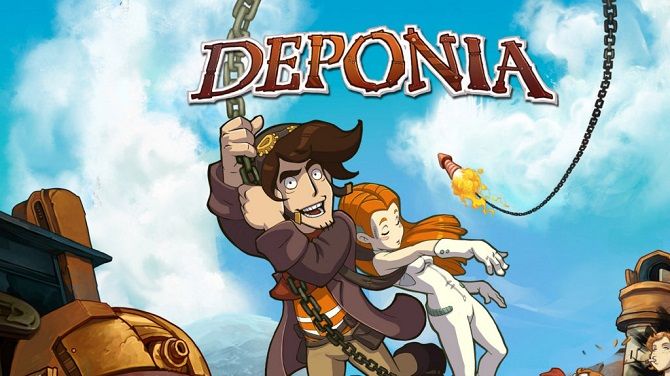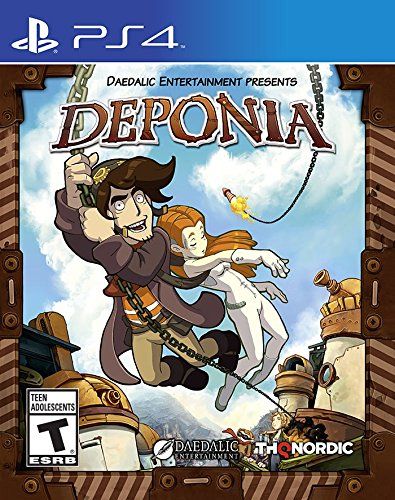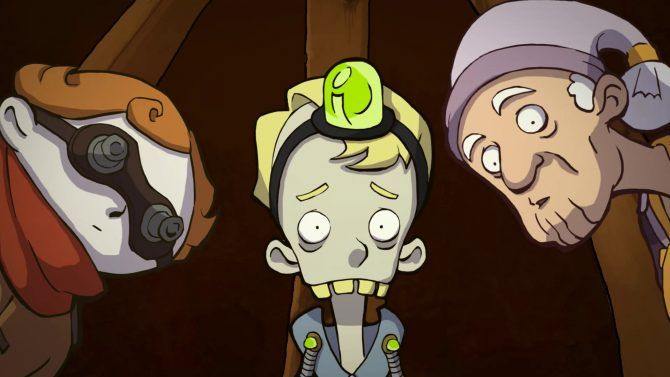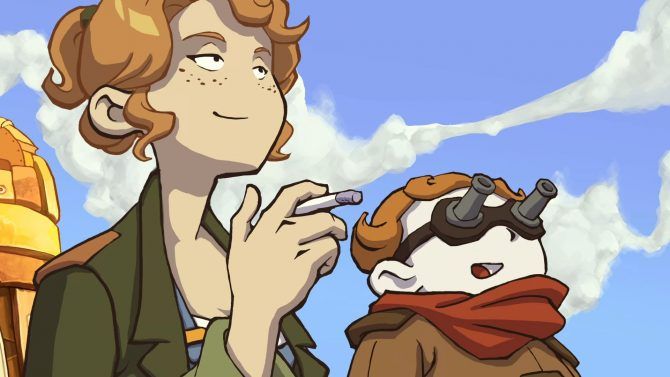Deponia has one of those settings that, as a reviewer, you want to latch onto for commentary. The game takes place on a miserable trash planet known as the titular ‘Deponia’ where the lower class go about their lives living amongst junk and eating contaminated food. However, there are clean water deposits found deep within the soil and that metaphor becomes hard to ignore: ‘This game is littered with trash but dig deep enough and you’ll find the good stuff!’ This isn’t exactly apt as Deponia does rise above its ‘garbage’ themed but nevertheless a lot of the experience isn’t exactly clean.
German developers Daedalic Entertainment actually released Deponia in 2012 on PC. This first entry was part of a full trilogy that concluded in 2013. However, the developers decided to make a fourth game for the series, Deponia Doomsday, that is coming out on the PS4 as well as PC. This in turn convinced Daedalic to bring over the original trilogy to the PS4 starting with the first game.
The port remains virtually the same except with some new controls to take advantage of the DualShock 4 controller. The two biggest things to take away from this history lesson is that Deponia is very much a European game and that it is part of a larger storyline told over multiple titles. Unfortunately, the entire adventure found in the first Deponia outing acts as a long prologue. Things happen, characters appear, conflicts are set up, but the plot moves at a snail’s pace.
The first half of the story can be summed up in a sentence: protagonist Rufus tries to escape his trash home-world but ends up knocking out a resident, Goal, from the upper-class flying city of Elysium. Most of your journey is spent trying to wake up this typical damsel in distress and it’s only in the final scenes of Deponia where the story actually takes off.
Gameplay itself is very much traditional PC adventure game fare. You pick up items, expand your inventory, and solve puzzles. There are a few logic mini-games sprinkled throughout to mix things up. However, the spotlight really falls on the unique setting and the humor of Rufus’ misadventures.
Deponia’s universe is highlighted through the cartoony aesthetic of the game’s characters and, to a lesser extent, its environments. Backgrounds tend to be highly detailed but drab in color; This fits in with the trash planet motif but doesn’t really catch the eye.
The animation and expressions of the characters are quite smooth; Rufus himself has a large number of unique actions and reactions. Not so smooth are the interaction between your avatar and the background as sometimes you’ll jump in front of and behind certain backgrounds or go to grab something that doesn’t line up with your hand.
The star of the game’s visuals are the character designs. The inhabitants are more interesting as the art style juggles a strange balance of European influences with Bugs Bunny wackiness. Characters such as Rufus’ (not) sidekick Wenzel and the village of Kuvaq’s doctor/police officer/firefighter Gizmo fully embrace their cartoony designs and the inherent humor found in the game.
There are other designs and choices that show just how outdated (or maybe cultural) some of the comedy is. For instance, the mayor’s secretary is a gruff looking (and sounding) man stuffed into a pink dress. Every so often ‘Lotti’ will do a falsetto with her voice to try in vain to sound more feminine. It comes across as very lazy humor and this attitude isn’t limited to just the art.
The quality of the voice acting and the oddness of some of the written dialogue really is where Deponia suffers the most. The (surprisingly) small amount of main characters are sufficiently portrayed to move the story along but miss the mark with the humor. This is most evident in the singing Chorus that ushers Rufus through the course of the game.
The character that strums on his guitar-like-thing during certain cutscenes looks, moves, and sounds bad. The accent on the actor is quite thick and songs are comprised of forced rhymes (‘paid’ does not sound like ‘said’) and garbled English. It’s necessary to have the subtitles on here to understand what the Chorus is saying, and even then, its usually nonsense passed off as humor.
This is not to say that the sound quality of the game is poor. You can hear all of the dialogue and music quite clearly (although on rare occasions the subtitles do not match up). There isn’t really much to say about the music design of the game: the ambient music does convey that you’re on a junk planet nicely but the fact that its sparse and loops often gets old quickly.
At this point you’ve probably noticed that I haven’t really talked about the main characters of Rufus and Goal much. For the latter that’s simple: she isn’t really given much of a personality until the end of the game. Rufus is a little more complicated. He’s made out to be a narcissistic scoundrel acting as our antihero but really he comes off as highly unlikable. This is mainly due to issues with the script.
Actor Kerry Shale does a good job of pushing Rufus through the entire game as the protagonist but there are many points where the flaws in the writing stand out. At one point Rufus makes a pun about an inventory item followed by a ‘Badoom!’ which seems to be a sad attempt to make a drumroll noise. He has strange expressions like ‘That’s all waste water under the bridge’ He constantly injures an unconscious Goal during the journey (it’s as a running gag) and makes snarky comments about it.
The best example of Rufus’ obnoxiousness and Deponia’s tone-deafness around humor comes from his interactions with his ex, Toni. She is shown with a cigarette constantly hanging out of her mouth and a rough demeanor. It looks like she’s supposed to be set up as the shrewish ex-girlfriend who constantly nags our hero. Charlotte Moore reads her lines as mildly annoyed does not even come close to matching Rufus’ terrible treatment of her.
Basically, Toni has given her slovenly ex a place to stay for free and all the while he mooches off her, refuses to do chores, and is needlessly mean to her. He even ‘accidentally’ killed her pet bird. And you as Rufus are expected to tranquilize her and steal from her store to solve a convoluted puzzle later on. Neither the acting nor the writing make this situation funny -- it constantly took me out of the game to know I was playing as this creep.
Speaking of that puzzle, it kind of underscores the weakest moments of the gameplay as well. Most of the time the game gives you decent clues on what to do and on a few occasions, there are small environmental clues that add to the most interesting brain teasers. But the puzzle design follows the obtuse history of logic from early adventure games. For instance, a funnel, a dart and some tranquilizer are combined into a makeshift blowgun so you can drug Toni.
You’ll find that the village of Kuvaq, which takes up a majority of the first half of the game, becomes a real slog. You’ll find items that won’t be used for a few hours later and you might even make an object that will have to be disassembled. That blowgun from earlier? I had to use the combined item to solve a puzzle where I needed the funnel in which it was disassembled. Then I had to put it all back together again.
I ended up falling into the tried and true formula of using every item in my ever-expanding inventory on all interactive objects. This is the calling card of a poorly designed adventure game. The new control scheme for the PS4 somehow made puzzle solving easier and harder at the same time.
The DualShock 4 controller is utilized quite well for a PC adventure game: the left analog stick moves Rufus whereas the right one moves the ‘mouse’ cursor. All the hotspots (there’s no pixel hunting here) for a screen can be cycled through with the R1 button and interacted with in multiple ways with the face buttons.
As you approach one of these objects of interest, the cursor will go to it automatically. However, there were some hiccups to the control scheme. I found the inventory screen a little unresponsive at times and some hotspots refused to let you try multiple objects on them in rapid succession: I had to drag the cursor back over each time.
The part that surprises me about all these frustrations I had with Deponia is that I actually want to play the sequel to see how the story plays out. I wish it hadn’t taken more than 10 hours of unfunny dialogue and confusing obstacles to get to the start of this tale but there were enough gems among the rubble to keep me invested.
Rufus might be a jerk but his interactions with a few characters in the last chapter of the game made me laugh (especially his conversation with a helpful boat captain that he keeps on accusing of being a pirate) and the narrative opened up enough to show the full potential of the series.
If you’re a fan of old-school adventure games that require stretches of the imagination and the strangest inventory items to solve, then I would recommend Deponia. If you’re more curious about the art style or the possibility of a humorous story, I’d suggest watching let’s play videos to get an idea of this glorified prologue. I don’t know what Chaos on Deponia holds but I’m hopeful that the series might mature with every new title.




